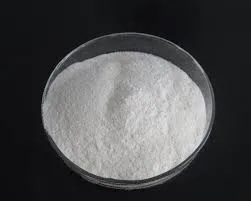
Dec . 14, 2024 04:37 Back to list
hydroxyethyl cellulose solubility
Understanding the Solubility of Hydroxyethyl Cellulose
Hydroxyethyl cellulose (HEC) is a non-ionic water-soluble polymer derived from cellulose, a natural polymer found in the cell walls of plants. This derivative is widely utilized across various industries, such as pharmaceuticals, cosmetics, food, and construction, due to its unique properties, such as thickening, binding, and film-forming capabilities. A vital characteristic of HEC is its solubility in water, which plays a crucial role in its applications and efficacy.
Chemical Structure and Properties of HEC
HEC is created through the etherification of cellulose using ethylene oxide. This process introduces hydroxyethyl groups into the cellulose structure, enhancing its solubility in water. The degree of substitution (DS), which refers to the average number of hydroxyethyl groups per anhydroglucose unit in the cellulose chain, significantly influences the solubility of HEC. Generally, higher DS leads to improved solubility in water and other polar solvents.
The solubility of HEC can be attributed to its hydrophilic nature. The hydroxyethyl groups impart hydrophilicity to the polymer, allowing it to interact favorably with water molecules. When HEC is mixed with water, hydrogen bonds form between the hydroxyethyl groups and water, facilitating dissolution. This property is especially important in applications requiring the formation of gels, emulsions, or viscous solutions.
Factors Affecting Solubility
Several factors influence the solubility of hydroxyethyl cellulose in water. These include temperature, pH, concentration, and ionic strength.
1. Temperature The solubility of HEC increases with temperature. Higher temperatures provide kinetic energy that enhances the dissolution process, allowing more molecules to escape from the solid state into the liquid solvent, thus increasing the overall solubility.
2. pH The pH of the solution can also affect the solubility of HEC. Although HEC is generally stable across a wide pH range, extreme acidic or basic conditions can lead to hydrolysis of the cellulose backbone or alteration of the ether groups, potentially impacting solubility.
hydroxyethyl cellulose solubility

3. Concentration The concentration of HEC in solution is critically important. At lower concentrations, HEC can dissolve easily and uniformly, but at higher concentrations, the solution may become viscous, and solubilization becomes more challenging. This is due to the increased intermolecular interactions and potential chain entanglement.
4. Ionic Strength The presence of salts or other ionic species can influence the solubility of HEC. Electrolytes can shield the hydrophilic groups in HEC, altering the solvation dynamics and, in some cases, reducing solubility.
Applications of HEC Based on Solubility
The solubility of hydroxyethyl cellulose makes it a versatile ingredient in a wide range of products. In the pharmaceutical industry, HEC is often used as a thickening agent in topical formulations, as it can form stable gels that enhance drug delivery. Its solubility aids in the formulation of controlled-release tablets and suspensions, providing a consistent release profile.
In the cosmetic industry, HEC is found in hair care products and skin creams. Its ability to dissolve in water enables the formulation of products that are easy to apply, providing a smooth texture while improving the sensory attributes of cosmetics.
Furthermore, in the construction sector, HEC serves as an essential component in cement and mortar mixtures. Its solubility ensures homogeneity in the mixture, improving workability and adhesion when applied to surfaces.
Conclusion
Hydroxyethyl cellulose's solubility in water is a fundamental aspect that significantly impacts its functionality and application across various industries. Understanding the factors influencing its solubility, such as temperature, pH, concentration, and ionic strength, can help formulators optimize their products for better performance. As a versatile polymer, HEC continues to play a crucial role in enhancing the effectiveness and user experience of numerous formulations in everyday life.
-
Versatile Hpmc Uses in Different Industries
NewsJun.19,2025
-
Redispersible Powder's Role in Enhancing Durability of Construction Products
NewsJun.19,2025
-
Hydroxyethyl Cellulose Applications Driving Green Industrial Processes
NewsJun.19,2025
-
Exploring Different Redispersible Polymer Powder
NewsJun.19,2025
-
Choosing the Right Mortar Bonding Agent
NewsJun.19,2025
-
Applications and Significance of China Hpmc in Modern Industries
NewsJun.19,2025







